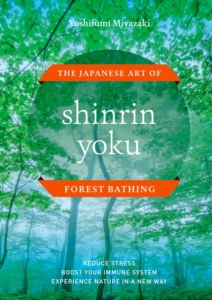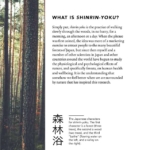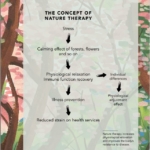Shinrin-Yoku: The Japanese Art of Forest Bathing
by Yoshifumi Miyazaki
AMBER LOVE 04-MAY-2018 My work is supported by the generous backers at Patreon.com/amberunmasked who appreciate my reviews and my stories; and they also get first access to what’s happening with my books and podcast. Also, I’m an Amazon Influencer so you can shop through my personal recommendations.
Book Review:

For as long as I can remember, I referred to any walk in the woods as “hiking.” I supposed to other people hiking refers to strenuous ascents and descents over mountains and cliffs. I believe it was in 2017 when I came across a meme on Instagram explaining that there’s a Japanese practice of walking through nature, particularly a forest, and soaking every bit of stimuli in which was called “shinrin-yoku.”
As a newly credentialed yoga teacher and still writer-at-large, I was immediately curious when I saw Yoshifumi Miyazaki’s book, “Shinrin-Yoku: The Japanese Art of Forest Bathing” on NetGalley’s catalog to review. The book will be available June 12, 2018 from Timber Press.
The word shinrin-yoku was coined in 1982 by Tomohide Akiyama, a forest worker who wanted to increase the number of visitors to Japan’s park systems. He invented this creative word shinrin-yoku which is translated as “forest bathing” and it worked. More people began going to their parks.
To get the best understanding of why the park visits were important, one has to look beyond the marketing and promotions of Japan’s park system and the calculating tally of visitors. It was intuitive to them that being in the forest, feeling the ground under their feet, listening to the birds, and smelling the deep fragrances of the earth improved their health.
In 1990, experiments began which measured the stress hormone cortisol of people as they experienced the forests. Various experiments and teams have started and stopped or started and drew the conclusions possible that day’s technology; but now there are modern 2018 scientists digging into the research of shinrin-yoku and its benefits.
The scientists plainly state that shinrin-yoku is not in itself a “medicinal cure.” It’s a preventative treatment that can keep stress-related illnesses at bay which alleviates the strain on medical services.
The author, Yoshifumi Miyazaki wants the term “forest therapy” to be used when referencing the scientific studies of shinrin-yoku. The book is filled with gorgeous photos and has a coffee table book style to the page design utilizing a lot of white space. Miyazaki incorporates quotes and lines of poetry (always something I love) pertinent to nature.
Practitioners and believers of Chinese feng shui will find a lot of Miyazaki’s advice relative to theirs. Bring the outdoors inside. Utilize what’s available whether it’s a park nearby or your backyard garden or a Bonzai tree. Yoga also unites the universe’s natural elements with humanity through multiple ways: poses corresponding to five sacred elements, chakra correspondences, the five koshas, and mudras just to illustrate a few examples.
“Shinrin-Yoku: The Japanese Art of Forest Bathing” includes diagrams to accompany Miyazaki’s text. Stress > leads a seeker to the forest > there’s a physiological reaction where the immune system gets a boost > (subjects may have differing outcomes) > Illness prevention > which would reduce the impact on health services. Miyazaki calls for sustainability due to the impact of urbanization. He states that it’s not a city versus nature battle: it’s a matter of human beings requiring exposure to elements that city’s dominate. He lists many contributing side effects to urbanization such as workload demands that are excessive, inability to get enough restful sleep, and constant over-stimulation leading to increases in serious health conditions. The book lays out the science of the biology and physiology in easy to understand language.
The message isn’t prosaic “Do it and you’ll feel better” mentality. The author gives clear conclusions to the health benefits.
If you are familiar with tree lore of the Celts, you will appreciate the section, “The Significance of Trees in Japan,” which breaks down the importance of five tree varieties: cedar, kadomatsu, bamboo, cherry blossom, and bonsai.
Chapter three dives into a huge offering of suggestive practices so that any reader would be able to find something that they are capable of doing. There are samples of meditation to do among those suggestions. There are tips on aromatherapy and the use of essential oils with notes on the chemistry and benefits of tree oils.
Even if you don’t think practices like yoga are “your thing” the basic foundation that fresh air and time unplugged from machines is good for you is something everyone can understand. If you are a fan of yoga, aromatherapy, stress relief programs, and practical ways to enjoy nature at home, this book gets my highest recommendation.



